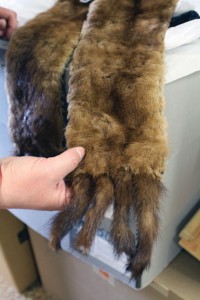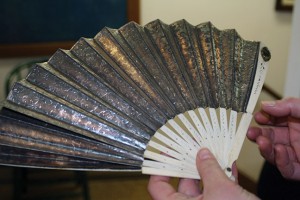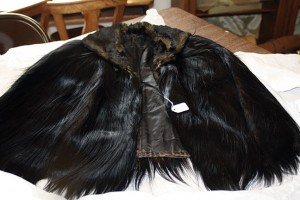Curator Elizabeth Hutchison and the volunteers helping to catalog the Mattapoisett Historical Society Museum’s collection of artifacts have seen some rare, unique items along the way – but nothing as strange as what they recently came across while sorting through a collection of clothing folded in tissue paper, packed in boxes for decades.
“It was a ‘What is this?’ kind of moment,” said Hutchison remembering the instant one of the volunteers called out, “What the heck is this?” while unfolding the white tissue paper inside a box, revealing a dark, long-haired furry-type of … cape, as it appeared. The group soon realized that these hairy pieces were of monkey fur, and a total of three monkey capes lay before them, seeing the light of day for the first time in a long time.
“One of the volunteers who was going through them was just like, ‘I’m not touching them,’” said Hutchison.
There was very little written about the monkey capes in the museum’s records, and Hutchison determined that the capes were from the 1930s when monkey fur fashion was revived. She paid particular attention to the style of the collars, which she said looked much like the 30s style.
“These are weird things,” said Hutchison. “We were like, ‘Why do we have monkey fur?’”
There are other furs in the collection. For example, Hutchison held up a brown fur shrug of an unidentified animal that still had fingers attached at the end like a fringe of sorts.
“And that’s kind of normal. I’ve seen that before, but…” she said. “With the monkeys were just like, “What?’”
Unfortunately, there is no documentation of the names of the people who once owned the monkey capes, said Hutchison. Many of the corresponding cards that Hutchison compared to receipts do not give more information than what the item is and the condition it is in.
Hutchison would rather pass on trying on the monkey capes, saying, “It just looks creepy to me,” likening it to human hair. It feels just like human hair and cascades down like it, as well. Which makes sense, when you think about how closely related we are as fellow primates.
“I’m not a fan of the fur, but I understand,” said Hutchison. “It’s warm. But, bleck!”
What shall become of the monkey capes of Mattapoisett? They will be catalogued, entered into the computer database, and carefully folded back up in white tissue paper and placed in their storage boxes for now. But soon, Hutchison hopes to have a show that would feature some of the weird, unique, and extraordinary items discovered in the collection over time.
“We actually have a lot of beautiful clothing that really shouldn’t just sit in a box,” she said. Hutchison pulled out a few other items she was fond of for their uniqueness and rarity such as a silver-gilded and ivory fan, one Hutchison’s favorite pieces.
Flip through an early 1900s Boy Scout Handbook and you’ll come across some strange suggestions for games, such as “Steal the Bacon.”
She unrolled an exceptionally long road map portraying the Route 6 corridor of Mattapoisett, and also spent a moment examining a small piece of a clay pipe from an ancient graveyard in Jamestown, Virginia dated in the early 1600s and, quite possibly, one of the oldest clay pipes brought to America.
“I think like with the monkey fur,” said Hutchison, “it would be fun to have an exhibit of the weirdest things we’ve found. Or a people’s choice sort of exhibit.”
And you never know, as Hutchison pointed out. There are still about ten boxes to go through of clothing. And as the monkey capes have shown us, there could be anything in there…
By Jean Perry


